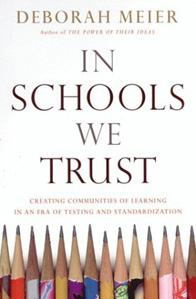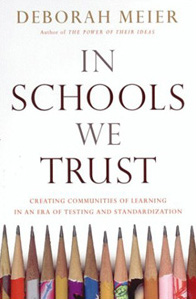The aspirational arithmetic behind that whole “study an hour a day to become an international expert in your field” thing goes something like this:
- Studying/reading an hour a day adds up to you reading/absorbing about a book a week;
- Which adds up to about 50 books over the year;
- Which adds up to a whole lot of learning.
Now, obviously, by setting more moderate goals about how much “ed-reading” I’m trying to do each day, I have ensured that my own personal arithmetic will be adding up a bit more modestly. Still, I’m pleased to say I’ve finished the first book I started when I set this plan for myself. Two-and-a-half weeks ain’t so bad, all things considered.
 Even though it’s a complete non-sequiteur, the first thing I noticed about Deborah Meier’s In Schools We Trust was that it was published by Beacon Press. I know of Beacon as the UUA‘s publishing house, but I’d not noticed till today what a vast array of non-UU books is in Beacon’s catalog. Upon reflection, this only makes sense, or else I fear Beacon might have what they call an “unsustainable business model.” Still, I hadn’t even remotely thought of Beacon as publishing education books till I picked this one up. Now I might as well export their entire catalog over to my reading wish list as I continue my ed-reading self-study project.
Even though it’s a complete non-sequiteur, the first thing I noticed about Deborah Meier’s In Schools We Trust was that it was published by Beacon Press. I know of Beacon as the UUA‘s publishing house, but I’d not noticed till today what a vast array of non-UU books is in Beacon’s catalog. Upon reflection, this only makes sense, or else I fear Beacon might have what they call an “unsustainable business model.” Still, I hadn’t even remotely thought of Beacon as publishing education books till I picked this one up. Now I might as well export their entire catalog over to my reading wish list as I continue my ed-reading self-study project.
But on to more substantive matters…
Meier’s book is subtitled Creating Communities of Learning in an Era of Testing and Standardization, and although it was published in 2002, it still senses, to my readerly eyes, as speaking to the current state of schools and schooling. After all, who could read the following passage —
[S]ocial distrust plays itself out in education in the form of draconian attempts to “restore accountability” through standardized schooling and increasing bureaucratization.
The tragedy of this approach is that it undermines what I think is the best way to make schools trustworthy and raise standards. Standardization and bureaucratization fuel the very distrust thy are aimed to cure. Even more tragically, standardization and bureaucratization undermine the possibilities for the kind of education we all claim is sorely lacking. (2)
— and not feel its contemporaneousness?
In case you’re interested, here’s a few other reviews:
- Coalition of Essential Schools
- International Forum of Educational Technology & Society (IFETS)
- A Teaching Life
Meier arranges her book into three sections. Part One discusses different aspects of building a culture of trust within schools: teacher collaboration, parent engagement, being aware of the powerful impacts and implications of race and class differences within the members of a school community (teachers, children, educators). Meier also discusses the importance of creating an environment where children feel safe taking learning risks:
Learning happens fastest when the novices trust the setting so much that they aren’t afraid to take risks, make mistakes, or do something dumb. Learning works best, in fact, when the very idea that it’s risky hasn’t even occurred to kids. . . . No one is sorting or ranking us. . . . We’re in the company of people who are most firmly on our side, no matter what. (18)
Throughout these chapters, Meier offers concrete suggestions drawn from her own experience founding small, innovative public schools in NYC and Boston. Meier outlines 7 key qualities for such schools on pages 20-22. To paraphrase:
- Safety, both physical safety from violence and also safety from ridicule and safety to learn and make mistakes.
- A supportive “expert-to-learner” ratio, achieved by understanding that school communities can draw on other adults and older peers to create a more vibrant & effective learning community.
- Opportunities for students to show their own expertise and passion for a topic/subject.
- Flexibility in how learners can experience, explore and assimilate new content knowledge.
- Setting aside rigid timetables to allow “time for ideas to grow” (21).
- Learning that is engaging and enjoyable.
- A commitment to connecting school/curricular content to students’ authentic, lived experiences.
Part Three of the book addresses some customary fallacies and misconceptions about the small-school movement, arguing against the common belief that small, successful urban schools are so rare, the products of such exceptional circumstances (a superstar principal, a deep-pocketed foundation, etc.) that their models of success could never be replicated to serve all the U.S. children in need of better, safer, more engaging schools. In fact, Meier argues, the “failures” often seen in attempts to scale up successful small schools are most often caused by city and state bureaucracies making choices that impose standardization at the cost of standards — at the cost of actual success in teaching and learning.
There’s no way to guarantee that any particular system will work, or will work forever, or will not need endless revising. But until we get over the idea that there is a one-size-fits-all solution to schools, above all for schools that are trustworthy enough to do the job well, we won’t allow ourselves to do the difficult long-term work of redesigning the system, not just the schools. What we need is a new kind of system whose central task is to protect the public space needed for innovation. We need a lean, mean system, with a limited but critical accountability function, to be the guardian of our common public interest, but one that respects the fact that schools must be first and foremost responsive to their own constituents — the members of their community — not to the system. That’s the rub. (172-3, emphasis added)
———-
You may have notched I skipped passed Part Two of Meier’s book. I did so because its contents — a devastating critique of standardized testing and its primacy in the U.S. educational system — seemed to me not-entirely connected to the book-ended discussion in Parts One and Three about what successful school models could look like and how to achieve them.
Don’t get me wrong: I think Meier’s critique of big testing is powerfully on point. When I called it a “devastating critique,” up above, that was not empty praise on my part.
Quite frankly, I’m afraid to start a more detailed summary with pull-quotes, for fear I will instead try to type out all 70 pages of this verbatim. And I just don’t have that kind of time.* Suffice to say, for the moment, that Meier has added immensely to the depth of my understanding of standardized testing, as well as to the depth of my contempt for its current use in schools. Even if you’re not interested in Meier’s thoughts about school design, Part Two of her book is eminently worth reading as its own little “capsule volume.”
So, a valuable first book in my new Earl-Nightengale-inspired ed-reading project. With any luck, I’ll finish book #2 at a similar fortnightly pace and circle back here.
Now all I need to do is figure out if there’s any sort of note-taking system I want to use to capture what I’m learning and any connections I start to make. Are these “21st century book reports” enough for that purpose, or is there something else that’s worth the doing?
* Or that level of disregard for copyright and the limits of “fair use” conventions.
———-
Image credit: http://en.wikipedia.org/wiki/In_Schools_We_Trust

